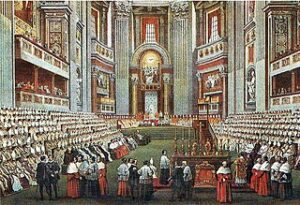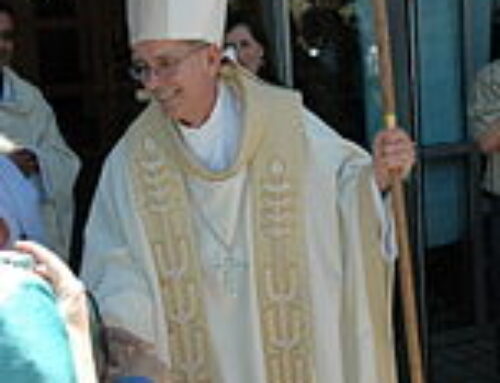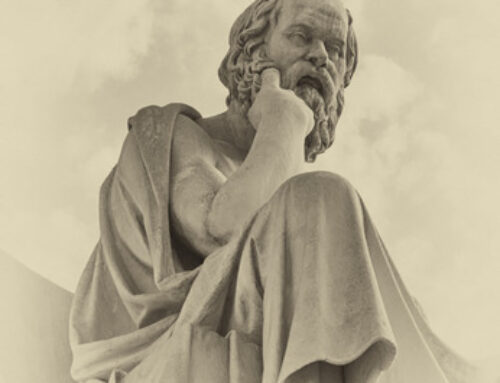 The Catholic hierarchy’s recent uproar over the idea of women deacons seems as intense as their uproar over blessing gay relationships has been. I find that puzzling. After all, there is nothing about women deacons that suggests sinfulness, whereas gay sexual behavior has long been considered a serious sin against nature. So why the equally intense concern over women deacons?
The Catholic hierarchy’s recent uproar over the idea of women deacons seems as intense as their uproar over blessing gay relationships has been. I find that puzzling. After all, there is nothing about women deacons that suggests sinfulness, whereas gay sexual behavior has long been considered a serious sin against nature. So why the equally intense concern over women deacons?
Let me begin by briefly explaining the uproar over each. The gay blessing controversy came first so I’ll begin there. Pope Francis approved blessings for same-sex couples as long as they do not give the impression that gay marriage is being endorsed. As he explained, “I do not bless a ‘homosexual marriage’; I bless two people who love each other.” Many bishops questioned this rationale, suggesting that it is almost impossible to give such a blessing without implying approval of gay marriage, which violates Catholic teaching.
Let’s now turn to the idea of allowing women to become deacons: When asked whether this was possible, Pope Francis said, “I will ask the (Congregation for the) Doctrine of the Faith to tell me if there are studies on this.” He did not assert a view, but merely promised to research the matter, yet the negative reaction was immediate and widespread. Fr. Gerald Murray’s reaction is an example.
Murray said: “The reason it’s not permitted is because the Church has never done it” . . . He went on to explain that the deaconate is merely the first part of a single sacrament, so “the issue here is not women deacons; the issue is women priests.” If this were approved, he argued, it “would mark a serious moment of heresy in the life of the Church because you would have the pope authorizing something that is impossible to happen—women being given the sacrament of Holy Orders.” He cited as his authority for this view Pope John Paul II’s 1994 apostolic letter Ordinatio Sacerdotalis.
Murray was correct in citing John Paul’s view as authoritative. In fact, it was even stronger than Murray suggested. John Paul said, “I declare that the Church has no authority whatsoever to confer priestly ordination on women and that this judgment is to be definitively held by all the Church’s faithful.“ At first glance, that wording suggests infallibility, which would close the issue.
However, the matter is more complicated, as Cardinal Joseph Ratzinger (later Pope Benedict XVI noted in a commentary on the teachings of the Magisterium. He explained that a doctrine may be believed by the Church for centuries, later be declared “definitive,” and then even later “the consciousness of the Church might progress to the point where [the] teaching could be defined as a doctrine to be believed as divinely revealed.”
The words “might progress” are significant; they cover the possibility that the teaching might not be considered divinely revealed.
Why is this fact important? As Dr. John Noonan explained in Development in Moral Doctrine, there have been cases in Catholic history in which long-standing teachings have not only not been classifed as divinely revealed but instead as deeply mistaken. One example concerns usury, making money from investments, which was regarded as gravely sinful. Another concerns slavery. which for centuries was embraced by pontiffs and saints as perfectly moral and citing Sacred Scripture as proof. In both cases, the teachings were later condemned as false.
So what, exactly, was John Paul’s rationale for regarding the issue as closed? His apostolic letter went on to say, “She [the Catholic Church] holds that it is not admissible to ordain women to the priesthood, for very fundamental reasons. These reasons include: the example recorded in the Sacred Scriptures of Christ choosing his Apostles only from among men; the constant practice of the Church, which has imitated Christ in choosing only men; and her living teaching authority which has consistently held that the exclusion of women from the priesthood is in accordance with God’s plan for his Church.”
Put more succinctly, John Paul was saying that a) Christ chose only men, b) the Church has followed Christ’s example, and c) the Church has consistently taught that excluding women is God’s plan.
Stating the message this simply raises several important questions: Could Christ have had a different reason for choosing only men as his Apostles? For example, might He have decided that expanding the role of women at that time and in that culture would have created an unnecessary impediment to the reception of His gospel message? Or might He have decided that the semi-transience of the Apostles’ lives and the paucity of accommodations in that time and place made the joining of men and women not only awkward but also inappropriate?
If either or both possibilities is true, would that not make today’s exclusion of women from the diaconate (and perhaps even the priesthood) unnecessary, since travel and living accommodations have evolved? Although the logical answer to this question is yes, I have no doubt that many members of the hierarchy are inclined to reject that entire line of thought.
Why do I say this? Because they have throughout their lives embraced Fr. Murray’s rationale that “The reason it’s not permitted is because the Church has never done it, [and because doing it] would mark a serious moment of heresy.” Clerics and laypeople alike have been taught that since childhood. And what makes this teaching stronger and more resistant to change than most others is that it has been reinforced by a centuries-old negative image of women. Part 2 of this essay will trace that image and its impact through time.
Copyright © 2024 by Vincent Ryan Ruggiero. All rights reserved.


